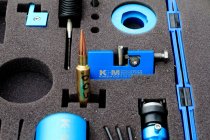Practical Tactical
you can control both neck tension and donuts if u inline, inside neck ream.
Merrill Martin wrote several articles in PS years ago about the above process. I started using that process years ago On all my NRA HP MR and LR rifles. Over several firings necks thicken and the neck thickness needs to be addressed. Any donuts that are beginning to form ( and they always do) are removed in this process as well. You can feel the necks thickening if u run ur brass over an expanding/ uniforming mandrel after sizing . Then it’s time to run the reamer thru the neck n trim out the excess. This process is performed in a die that holds the case in alignment as a reamer is run in thru the top of the die. Keeps things aligned with the centerline of the case.
I always thought Merrill was a very innovative guy.
I may have a copy of that PS as it does sound familiar, but I have never gone so far as to purchase anything for inside neck reaming. I could never find a product that I had enough confidence in to purchase.
If there is something out there that works really well, I'd certainly like to hear about it.
Last edited:












